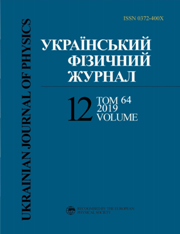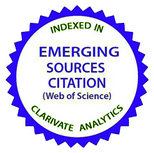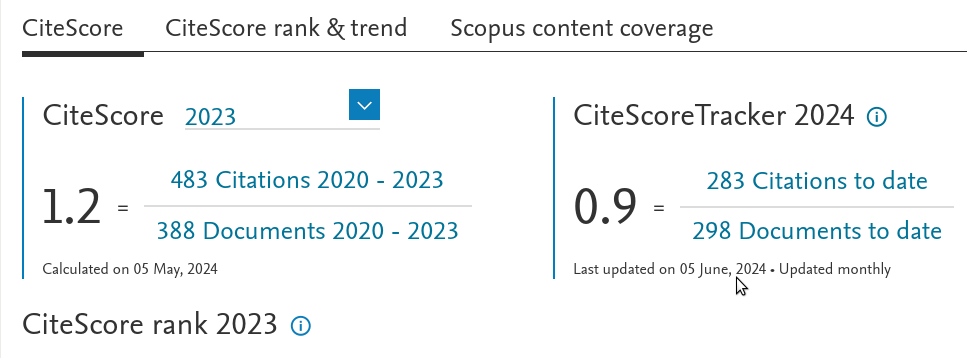Рівняння Фрадкіна для частинки зі спіном 3/2 у зовнішньому електромагнітному та ґравітаційному полях
DOI:
https://doi.org/10.15407/ujpe64.12.1112Ключові слова:
Gel’fand–Yaglom formalism, spin-3/2 particle, Fradkin theory, external electromagnetic field, curved space-time, non-minimal interaction, Majorana particleАнотація
Дослiджено модель Фрадкiна для частинки зi спiном 3/2 у присутностi зовнiшнiх полiв. Застосовуючи загальний формалiзм Гельфанда–Яглома, ми розвинули цю модель на основi набору iз шести незвiдних представлень власної групи Лоренца, що породжує 20-компонентну хвильову функцiю. Накладаючи стандартнi вимоги, такi як релятивiстська iнварiантнiсть, ненульова маса, спiн S = 3/2, P-симетрiя та iснування лагранжiану для цiєї моделi, ми спочатку отримуємо систему спiнорних рiвнянь за вiдсутностi зовнiшнiх полiв. Хвильова 20-компонентна функцiя складається з бiспiнора i вектор-спiнора. Якщо зовнiшнi поля вiдсутнi, модель Фрадкiна зводиться до мiнiмальної теорiї Паулi–Фiрца (або Рарiти–Швiнгера). Детально розглянута ця еквiвалентнiсть. Далi ми враховуємо зовнiшнє електромагнiтне поле. Виявляється, що рiвняння Фрадкiна у мiнiмальнiй формi мiстить додатковий член взаємодiї, який визначається електромагнiтним тензором Fab. Крiм того, ми враховуємо викривленiсть простору-часу. У загальноковарiантному випадку рiвняння Фрадкiна мiстить додатковий член гравiтацiйної взаємодiї, який визначається тензором Рiччi Rab. Якщо електричний заряд частинки рiвний нулевi, модель Фрадкiна залишається правильною i описує нейтральну частинку майоранiвського типу зi спiном 3/2, яка додатково взаємодiє з викривленням простору через тензор Рiччi.
Посилання
P.A.M. Dirac. Relativistic wave equations. Proc. R. Soc. London. A 155, 447 (1936). https://doi.org/10.1098/rspa.1936.0111
E. Majorana. Teoria simmetrica dell electrone e dell positrone. Nuovo Cimento 14, 171 (1937). https://doi.org/10.1007/BF02961314
M. Fierz. Uber die relativistische theorie Kraftefreier-Teilchen mit beliebigem spin. Helv. Phys. Acta. 12, 3 (1939).
W. Pauli. Uber relativistische Feldleichungen von Teilchen mit beliebigem spin im elektromagnetishen feld. Helv. Phys. Acta. 12, 297 (1939).
V.L. Ginzburg, Ya.A. Smorodinsky. On wave equations for particles with variable spin. Zh. Eksp. Teor. Fiz. 13, 274 (1943).
A.S. Davydov.Wave equations of a particle having spin 3/2 in absence of field. Zh. Eksp. Teor. Fiz. 13, 313 (1943).
H.J. Bhabha, Harish-Chandra. On the theory of point particles. Proc. Roy. Soc. London. A 183, 134 (1944). https://doi.org/10.1098/rspa.1944.0026
H.J. Bhabha. Relativistic wave equations for the proton. Proc. Indian Acad. Sci. A 21, 241 (1945). https://doi.org/10.1007/BF03046927
H.J. Bhabha. Relativistic wave equations for elementary particles. Rev. Mod. Phys. 17, 200 (1945). https://doi.org/10.1103/RevModPhys.17.200
H.J. Bhabha. The theory of the elementary particles. Rep. Progr. Phys. 10, 253 (1946). https://doi.org/10.1088/0034-4885/10/1/310
I.M. Gel'fand, A.M. Yaglom. General relativistic invariant equations and infinitely dimensional representation of the Lorentz group. Zh. Eksp. Teor. Fiz. 18, 703 (1948).
E.E. Fradkin. To the theory of particles with higher spins. Zh. Eksp. Teor. Fiz. 20, 27 (1950).
F.I. Fedorov. On minimal polynomials of matrices of relativistic wave equations. Doklady AN SSSR. 79, 787 (1951).
F.I. Fedorov. To the theory of a spin 2 particle. Uch. Zapiski Belor. State Univ. Ser. Fiz.-Mat. 12, 156 (1951).
H.J. Bhabha. An equation for a particle with two mass states and positive charge density. Phil. Mag. 43, 33 (1952). https://doi.org/10.1080/14786440108520964
F.I. Fedorov. Generalized relativistic wave equations. Doklady AN SSSR 82, 37 (1952).
M. Petras. A contribution of the theory of the Pauli-Fierz's equations a particle with spin 3/2. Czech. J. Phys. 5, 169 (1955). https://doi.org/10.1007/BF01689195
M. Petras. A note to Bhabha's equation for a particle with maximum spin 3/2. Czech. J. Phys. 5, 418 (1955). https://doi.org/10.1007/BF01689195
V.Ya. Fainberg. To the interaction theory of the particles of the higher spins with electromagnetic and meson fields. Trudy FIAN SSSR. 6, 269 (1955).
V.L. Ginzburg. On relativistic wave equations with a mass spectrum. Acta Phys. Pol. 15, 163 (1956).
H. Shimazu. A relativistic wave equation for a particle with two mass states of spin 1 and 0. Progr. Theor. Phys. 16, 285 (1956). https://doi.org/10.1143/PTP.16.287
T. Regge. On properties of the particle with spin 2. Nuovo Cimento 5, 325 (1957). https://doi.org/10.1007/BF02855242
L.A. Shelepin. Covariant theory of relativistic wave equations. Nucl. Phys. 33, 580 (1962). https://doi.org/10.1016/0029-5582(62)90550-3
A.Z. Capri. Non uniqueness of the spin 1/2 equation. Phys. Rev. 178, 1811 (1969). https://doi.org/10.1103/PhysRev.187.1811
A.Z. Capri. First order wave equations for multimass fermions. Nuovo Cimento. B 64, 151 (1969). https://doi.org/10.1007/BF02710288
F.I. Fedorov, V.A. Pletyukhov. Wave equations with repeated representations of the Lorentz group. Half-integer spin. Proc. Nat. Acad. Sci. of Belarus. Phys.-Math. series 3, 78 (1970).
F.I. Fedorov, V.A. Pletyukhov. Wave equations with repeated representations of the Lorentz group. Proc. Nat. Acad. Sci. of Belarus. Phys.-Math. series 6, 81 (1969).
V.A. Pletyukhov, F.I. Fedorov. The wave equation with repeated representations for spin 0 particle. Proc. Nat. Acad. Sci. of Belarus. Phys.-Math. series 2, 79 (1970).
F.I. Fedorov, V.A. Pletyukhov. Wave equations with repeated representations of the Lorentz group. Half-integer spin. Proc. Nat. Acad. Sci. of Belarus. Phys.-Math. series 3, 78 (1970).
V.A. Pletyukhov, F.I. Fedorov. Wave equation with repeated reprentations for a spin 1 particle. Proc. Nat. Acad. Sci. of Belarus. Phys.-Math. series 3, 84 (1970).
A. Shamaly, A.Z. Capri. First-order wave equations for integral spin. Nuovo Cimento. B 2, 235 (1971). https://doi.org/10.1007/BF02723086
A.Z. Capri. Electromagnetic properties of a new spin-1/2 field. Progr. Theor. Phys. 48, 1364 (1972). https://doi.org/10.1143/PTP.48.1364
A. Shamaly, A.Z. Capri. Unified theories for massive spin 1 fields. Can. J. Phys. 51, 1467 (1973). https://doi.org/10.1139/p73-195
M.A.K. Khalil. Properties of a 20-component spin 1/2 relativistic wave equation. Phys. Rev. D 15, 1532 (1977). https://doi.org/10.1103/PhysRevD.15.1532
M.A.K. Khalil. An equivalence of relativistic field equations. Nuovo Cimento. A 45, 389 (1978). https://doi.org/10.1007/BF02730078
L. Garding. Mathematics of invariant wave equations. In Lect. Notes in Physics 73, 102 (1978). https://doi.org/10.1007/BFb0032331
A.A. Bogush, V.V. Kisel. Equations with repeated representations of the Lorentz group and Pauli interaction. Proc. Nat. Acad. Sci. of Belarus. Phys.-Math. series. 3, 61 (1979).
W. Cox. Higher-rank representations for zero-spin filds theories. J. Phys. A 15, 627 (1982). https://doi.org/10.1088/0305-4470/15/2/029
W. Cox. First-order formulation of massive spin-2 field theories. J. Phys. A 15, 253 (1982). https://doi.org/10.1088/0305-4470/15/1/034
P.M. Mathews, B. Vijayalakshmi, M. Sivakuma. On the admissible Lorentz group representations in unique-mass, unique-spin relativistic wave equations. J. Phys. A 15, 1579 (1982). https://doi.org/10.1088/0305-4470/15/11/002
P.M. Mathews, B. Vijayalakshmi. On inequivalent classes unique-mass-spin relativistic wave equations involving repeated irreducible representations with arbitrary multiplicities. J. Math. Phys. 25, 1080 (1984). https://doi.org/10.1063/1.526250
W. Cox. On the Lagrangian and Hamiltonian constraint algorithms for the Rarita-Schwinger field coupled to an external electromagnetic field. J. Phys. A 22, 1599 (989). https://doi.org/10.1088/0305-4470/22/10/015
S. Deser, A. Waldron. Inconsistencies of massive charged gravitating higher spins. Nucl. Phys. B 631, 369 (2002). https://doi.org/10.1016/S0550-3213(02)00199-2
E.M. Ovsiyuk, V.V. Kisel, Y.A. Voynova, O.V. Veko, V.M. Red'kov. Spin 1/2 particle with anomalous magnetic moment in a uniform magnetic field, exact solutions. Nonlinear Phenomena in Complex Systems 19, 153 (2016).
V. Kisel, Ya. Voynova, E. Ovsiyuk, V. Balan, V. Red'kov. Spin 1 particle with anomalous magnetic moment in the external uniform magnetic field. Nonlin. Phen. Complex Syst. 20, 21 (2017).
A.M. Ishkhanyan, O. Florea, E.M. Ovsiyuk, V.M. Red'kov. Dirac-K¨ahler particle in Riemann spherical space: Boson interpretation. Canad. J. Phys. 93, 1427 (2015). https://doi.org/10.1139/cjp-2015-0143
V.A. Pletjukhov, V.M. Red'kov, V.I. Strazhev. Relativistic Wave Equations and Intrinsic Degrees of Freedom (Belarus. Science, 2015). 328 p.
V.V. Kisel, V.A. Pletyukhov, V.V. Gilewsky, E.M. Ovsiyuk, O.V. Veko, V.M. Red'kov. Spin 1/2 particle with two mass states, interaction with external fields. Nonlin. Phen. Complex Syst. 20, 404 (2017).
E.M. Ovsiyuk, O.V. Veko, Ya.A. Voynova, V.V. Kisel, V. Balan, V.M. Red'kov. Spin 1/2 particle with two masses in magnetic field. Appl. Sci. 20, 148 (2018).
V.V. Kisel, E.M. Ovsiyuk, O.V. Veko, Ya.A. Voynova, V. Balan, V.M. Red'kov. Elementary Particles with Internal Structure in External Fields. I. General Theory, II. Physical Problems (Nova Sci. Publ., 2018).
Downloads
Опубліковано
Як цитувати
Номер
Розділ
Ліцензія
Ліцензійний Договір
на використання Твору
м. Київ, Україна
Відповідальний автор та співавтори (надалі іменовані як Автор(и)) статті, яку він (вони) подають до Українського фізичного журналу, (надалі іменована як Твір) з одного боку та Інститут теоретичної фізики імені М.М. Боголюбова НАН України в особі директора (надалі – Видавець) з іншого боку уклали даний Договір про таке:
1. Предмет договору.
Автор(и) надає(ють) Видавцю безоплатно невиключні права на використання Твору (наукового, технічного або іншого характеру) на умовах, визначених цим Договором.
2. Способи використання Твору.
2.1. Автор(и) надає(ють) Видавцю право на використання Твору таким чином:
2.1.1. Використовувати Твір шляхом його видання в Українському фізичному журналі (далі – Видання) мовою оригіналу та в перекладі на англійську (погоджений Автором(ами) і Видавцем примірник Твору, прийнятого до друку, є невід’ємною частиною Ліцензійного договору).
2.1.2. Переробляти, адаптувати або іншим чином змінювати Твір за погодженням з Автором(ами).
2.1.3. Перекладати Твір у випадку, коли Твір викладений іншою мовою, ніж мова, якою передбачена публікація у Виданні.
2.2. Якщо Автор(и) виявить(лять) бажання використовувати Твір в інший спосіб, як то публікувати перекладену версію Твору (окрім випадку, зазначеного в п. 2.1.3 цього Договору); розміщувати повністю або частково в мережі Інтернет; публікувати Твір в інших, у тому числі іноземних, виданнях; включати Твір як складову частину інших збірників, антологій, енциклопедій тощо, то Автор(и) мають отримати на це письмовий дозвіл від Видавця.
3. Територія використання.
Автор(и) надає(ють) Видавцю право на використання Твору способами, зазначеними у п.п. 2.1.1–2.1.3 цього Договору, на території України, а також право на розповсюдження Твору як невід’ємної складової частини Видання на території України та інших країн шляхом передплати, продажу та безоплатної передачі третій стороні.
4. Строк, на який надаються права.
4.1. Договір є чинним з дати підписання та діє протягом усього часу функціонування Видання.
5. Застереження.
5.1. Автор(и) заявляє(ють), що:
– він/вона є автором (співавтором) Твору;
– авторські права на даний Твір не передані іншій стороні;
– даний Твір не був раніше опублікований і не буде опублікований у будь-якому іншому виданні до публікації його Видавцем (див. також п. 2.2);
– Автор(и) не порушив(ли) права інтелектуальної власності інших осіб. Якщо у Творі наведені матеріали інших осіб за виключенням випадків цитування в обсязі, виправданому науковим, інформаційним або критичним характером Твору, використання таких матеріалів здійснене Автором(ами) з дотриманням норм міжнародного законодавства і законодавства України.
6. Реквізити і підписи сторін.
Видавець: Інститут теоретичної фізики імені М.М. Боголюбова НАН України.
Адреса: м. Київ, вул. Метрологічна 14-б.
Автор: Електронний підпис від імені та за погодження всіх співавторів.

















